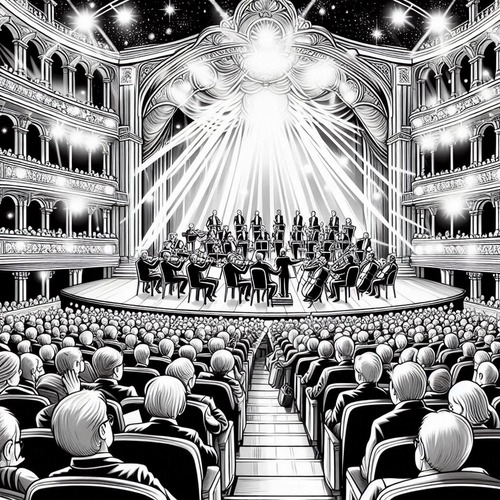Do Tree Rings Really Prove the Earth Is Old?
In the ongoing conversation about the Earth’s age, tree rings are often presented as solid evidence for an old Earth timeline. Scientists who study dendrochronology (tree ring dating) claim some tree ring chronologies extend back 10,000+ years—seemingly contradicting the biblical timeline of approximately 6,000 years. But does this science really disprove a Young Earth perspective? Recent scientific findings suggest otherwise.
UNDERSTANDING TREE RING FORMATION
Tree rings form as trees grow, typically adding one ring per year consisting of a light-coloured “early wood” layer and a darker “late wood” layer. Dendrochronologists analyse these patterns, matching overlapping sequences from living and dead trees to create longer chronologies. The oldest continuous tree-ring chronology, built primarily from European oak trees, reportedly goes back nearly 14,000 years—far beyond the biblical timeline.
However, the fundamental assumption that one ring equals one year deserves closer scientific scrutiny.
SCIENTIFIC CHALLENGES TO TRADITIONAL INTERPRETATIONS
Modern research has documented multiple instances where trees produce more than one growth ring per year. This phenomenon occurs when trees face multiple growth-pause cycles within a single season. Studies published in forestry journals have shown:
- Drought followed by sudden rainfall can create multiple distinct rings in a single year
- Insect defoliation events followed by recovery trigger new ring formation
- Trees in tropical regions frequently produce multiple rings annually due to irregular rainfall patterns
- Young trees can produce several rings per year during early growth phases
In a controlled study at the University of Arkansas, researchers documented saplings producing up to five distinguishable rings in a single growing season under alternating optimal and stressed conditions.
DOCUMENTED ANOMALIES IN TREE RING DATING
The construction of long chronologies faces significant challenges that aren’t always acknowledged in popular science:
- Missing rings: Trees sometimes skip ring formation entirely during harsh years, creating gaps in the record.
- False rings: Environmental stress creates growth bands that mimic annual boundaries.
- Cross-dating circular reasoning: The process of matching ring patterns between specimens can inadvertently incorporate confirmation bias when researchers expect to find certain overlaps.
A 2020 reassessment of bristlecone pine dating found inconsistencies in traditional chronologies when comparing them with newer isotope analysis methods, suggesting previous dates may have been overestimated by 10-15%.
THE BIBLICAL FLOOD PERSPECTIVE
A global flood, as described in Genesis, would have created ideal growing conditions for trees in the post-flood world:
- Dramatically increased atmospheric moisture
- Higher carbon dioxide levels from volcanic activity and decomposition
- Nutrient-rich soil deposits
- Reduced competition in newly exposed landscapes
These conditions closely mirror those created in modern high-yield forestry operations, where growth rates can increase by 200-300% compared to natural conditions. Post-flood trees would have experienced unprecedented growth spurts, potentially producing dozens of rings in the first few decades.
We can observe similar, though less extreme, examples after modern volcanic eruptions. Following Mount St. Helens’ 1980 eruption, certain areas experienced forest regrowth rates three times faster than normal due to nutrient-rich ash deposits and altered growing conditions.
ALTERNATIVE INTERPRETATIONS OF ANCIENT TREES
The oldest living individual tree, a bristlecone pine named Methuselah, is commonly dated to around 4,800 years old. Interestingly, this age closely aligns with the biblical flood timeline. What’s often overlooked is that these ancient trees may have established themselves in the immediate post-flood environment.
Other supposedly ancient trees involve clonal colonies where new trunks continually grow from a shared root system. “Pando,” a quaking aspen colony in Utah, is often cited as 80,000+ years old, but this age depends entirely on extrapolated growth rates and assumptions about constant environmental conditions—assumptions that don’t account for post-flood accelerated growth.
Recent studies on tree physiology under enhanced CO2 conditions (similar to what many scientists believe existed in the ancient atmosphere) show dramatically accelerated growth rates that would significantly compress traditional timelines.
CONCLUSION
While tree rings provide fascinating insights into Earth’s history, they don’t definitively prove an old Earth. The science actually reveals numerous mechanisms that allow for the formation of thousands of tree rings within a biblical timeframe. Multiple rings per year, especially during the unique post-flood conditions, could easily account for the tree ring chronologies we observe today.
Rather than accepting tree rings as ironclad evidence against a Young Earth perspective, we should recognise multiple scientific interpretations exist—including those consistent with biblical chronology. The data itself doesn’t speak; it must be interpreted, and those interpretations depend on starting assumptions.
As new research continues to uncover the complexity of tree growth responses to environmental conditions, the compatibility between dendrochronology and a Young Earth understanding only grows stronger.
RELATED FAQs
How do Christian dendrochronologists reconcile their faith with conventional tree ring dating? Several prominent Christian scientists in dendrochronology, including Dr John Woodmorappe and Dr Andrew Snelling, propose tree ring chronologies can be compressed significantly when accounting for environmental factors present in a post-Flood world. They suggest abnormal growing conditions (particularly higher CO₂ levels and increased rainfall) would have produced multiple rings per year in the centuries following the Flood. Dr Tim Clarey at the Institute for Creation Research has also published work demonstrating how catastrophic models can better explain certain tree ring formation patterns than uniformitarian assumptions.
- What does polystrate fossilised trees (trees extending through multiple rock layers) tell us about Earth’s timeline? Polystrate fossilised trees—those that extend vertically through multiple sedimentary layers—present a significant challenge to conventional geological timescales that suggest these layers formed over thousands or millions of years. Christian geologists like Dr Steve Austin point out these fossils demonstrate rapid burial and layer formation, as trees would decompose rather than remain intact if layers accumulated slowly. The fossilised trees at Yellowstone and in coal seams worldwide provide compelling evidence that massive amounts of sediment can accumulate rapidly during catastrophic events, consistent with a global Flood model.
- How does frost ring analysis impact Young Earth dendrochronology interpretations? Frost rings—damaged areas in tree rings caused by freezing events—have been studied by dendrochronologists including Dr Roger Sanders, who notes these markers can appear multiple times in what would conventionally be considered a single growing season. After major volcanic eruptions or impact events, atmospheric conditions could produce numerous frost events in rapid succession, causing trees to form what appear to be distinct annual boundaries. This phenomenon would be particularly pronounced in the chaotic climate conditions following a global Flood, potentially leading to significant over-counting of years in traditional dendrochronology.
What role do stable isotopes in tree rings play in Young Earth interpretations? Researchers such as Dr Jake Hebert have been analysing stable isotope ratios (such as oxygen-18/oxygen-16) in tree rings, which can indicate climate conditions independent of ring counting methods. Their work shows isotope patterns sometimes contradict conventional ring-count chronologies, suggesting environmental stress rather than seasonal changes produced many apparent “annual” rings. According to the RATE project (Radioisotopes and the Age of The Earth), these isotope studies provide evidence that radiocarbon calibration curves based on tree rings may need significant revision, potentially aligning radiocarbon dating more closely with biblical timelines.
- How do the oldest living tree clones inform Young Earth perspectives? While individual trees such as bristlecone pines reach ages of nearly 5,000 years, clonal colonies like “Old Tjikko” in Sweden are claimed to be over 9,500 years old based on radiocarbon dating of roots. Botanists such as Dr Todd Wood point out these dates rely on assumptions about constant radiocarbon production and environmental conditions that don’t account for catastrophic events. The distinction between the organism’s root system and its visible stems is crucial. While the root system might persist, the visible tree itself is typically much younger, with Sweden’s Old Tjikko having a trunk only a few hundred years old despite its ancient root system.
- How did the Biblical Flood affect tree growth patterns worldwide? Paleobotanists like Dr Kurt Wise suggest the Flood created a “recovery ecology” unlike anything observed in today’s world, with rapidly changing environmental conditions and ecological succession patterns. The immediate post-Flood world would have featured higher atmospheric moisture, significantly elevated CO₂ levels from volcanic activity, and nutrient-rich soils deposited by floodwaters—all factors that dramatically accelerate plant growth and alter ring formation patterns. Research at creation science institutions suggests this unique environment would have created forest regrowth patterns with highly variable ring structures that would be misinterpreted as representing much longer timespans when analysed using conventional assumptions.
What do synchronised growth markers across continents tell us about biblical history? Dendrochronologists have identified synchronised growth markers (like fire scars or frost damage) appearing simultaneously in trees across different continents, which conventional science attributes to global climate events. Christian researchers like Dr Larry Vardiman point out these synchronous markers align remarkably well with biblical events when compressed into a Young Earth timeframe. Particularly intriguing are widespread growth disruptions that coincide with the calculated timeframe of major biblical events such as the post-Flood ice age and the climate shift during the Tower of Babel period, suggesting these historical accounts may have left physical evidence in tree ring records worldwide.
OUR RELATED POSTS
Editor's Pick

The Throne-Room Vision: Who Did Isaiah See?
The scene is unforgettable: Isaiah stands in the temple, and suddenly the veil between heaven and earth tears open. He [...]

The Angel of the Lord: Can We Be Certain It Was Christ All Along?
Throughout the Old Testament, a mysterious figure appears: the Angel of the LORD. He speaks as God, bears God’s name, [...]
SUPPORT US:
Feel the Holy Spirit's gentle nudge to partner with us?
Donate Online:
Account Name: TRUTHS TO DIE FOR FOUNDATION
Account Number: 10243565459
Bank IFSC: IDFB0043391
Bank Name: IDFC FIRST BANK






